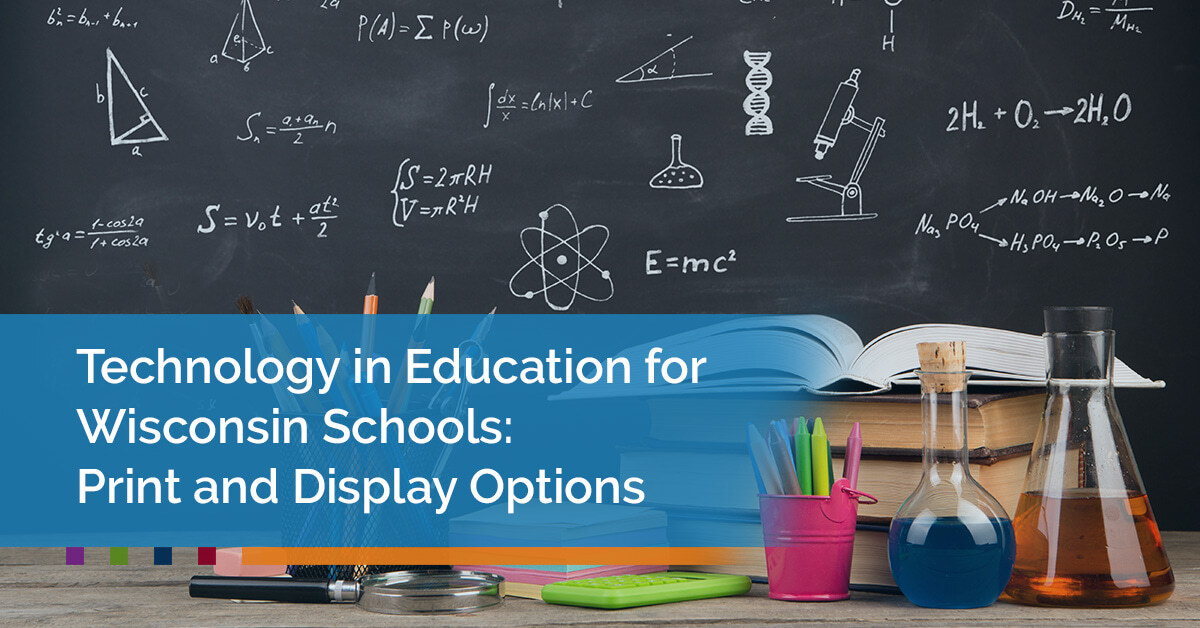Technology in Education for Wisconsin Schools: Print and Display Options
In terms of national rankings, Wisconsin schools are on the rise. The state has consistently outperformed its neighbors in the Midwest, and is now approaching top national rankings for academic performance.
In 2018, Wisconsin rose five spots in the U.S. News and World Report, obtaining the 18th national rank in overall education. The state’s high school graduation rate stands as the 6th best in the nation, as do its math scores according to the National Assessment of Educational Progress (NAEP).
Wisconsin NAEP reading scores rank among the nation’s best, occupying the 8th slot as of 2018. Five of the state’s schools earned gold medals in the U.S. News and World’s Report’s ranking of best schools in the United States, with Whitefish Bay High earning the top place.
These figures are encouraging, but they don’t represent the full potential of Wisconsin’s student body. Schools that implement new technology can empower their best students to perform better on national rankings, and give struggling students a much better chance at gaining mastery over tough subjects.
How Technology in Education Helps Wisconsin Schools Achieve More
Technology is quickly earning its place in the classroom. From tablet computers or interactive displays, the use of sophisticated devices helps to prepare students for the technological reality of the workforce they will enter upon graduation.
But technology in education means more than simply mapping old methods to new mediums. That approach doesn’t make full use of the real benefit of technology in education – the ability to personalize learning content to adapt to student needs.
Since the very beginning of systematic education as a discipline, teachers have had to compromise their curriculums in response to a seemingly inescapable fact: some students learn faster than others. Managing a classroom effectively meant striking the right balance in terms of learning speed.
This makes sense when there is one textbook for each subject, one chalkboard, one teacher, and many individual students. Technology evens the playing field by allowing personalized content to reach each individual student, giving them the ability to learn at their own pace without influencing other students’ progress.
This is especially important in early learning environments. Young children who struggle academically are at the highest risk of low performance later in life. These children often develop stigmas related to their learning ability, which further reduces their ability to succeed.
Technology solutions like DreamBox give young students the ability to take their time understanding concepts, progressing at their own pace. They expand opportunities for instruction by augmenting teachers’ abilities to help students approach the subjects that challenge them the most.
Obstacles to Implementing Best-in-class Education Technology in Wisconsin
Education technology in the classroom offers academic institutions the ability to personalize the learning experience. Outside the classroom, sophisticated print and networking solutions can reduce school’s reliance on expensive and outdated paper-based processes.
But Wisconsin educators don’t have it easy when it comes to implementing new technology. The state’s education budget remains lower than it was in 2009, and state leadership seems unlikely to change that in a meaningful way.
Educators are under pressure to deliver more with less. For some school administrators, this puts investing in sophisticated technology firmly outside the realm of economic feasibility – but this perspective doesn’t take the cost-saving nature of technology into account.
For instance, managed print services can empower teachers and students to reduce the cost of every paper page printed at school. A comprehensive print assessment can allow school administrators to pinpoint inefficiencies and develop policies that hold users accountable for print fleet usage.
Interactive displays can drastically reduce long-term education spending by reducing schools’ consumable purchases. While interactive displays have higher upfront costs than whiteboards, calculating total cost of ownership can make them a more cost-effective long-term investment for schools with tight budgets.
Managed networking services can also reduce unnecessary technology expenses while ensuring schools have the best solutions on the market available to them. Implementing world-class network infrastructure ensures that both teachers and students enjoy unlimited access to learning materials in the classroom and at home.
Invest in Education IT to Improve Student Performance Efficiently
Educators need expert consulting in order to maximize the benefits of education technology in Wisconsin. Relying on the comprehensive assessment of a reputable print, display, and networking dealer is the first step towards deploying best-in-class equipment in classrooms throughout the state.
At James Imaging, our team provides imaging products supported by some of the state’s most experienced tech professionals. We use sophisticated assessment technology to capture data and then interpret that data to identify opportunities for increased efficiency in the school system. This increases the security and productivity of document-related processes.
Is it time for your academic institution to benefit from the latest technology solutions in education? Speak to one of our experts to start the process.


